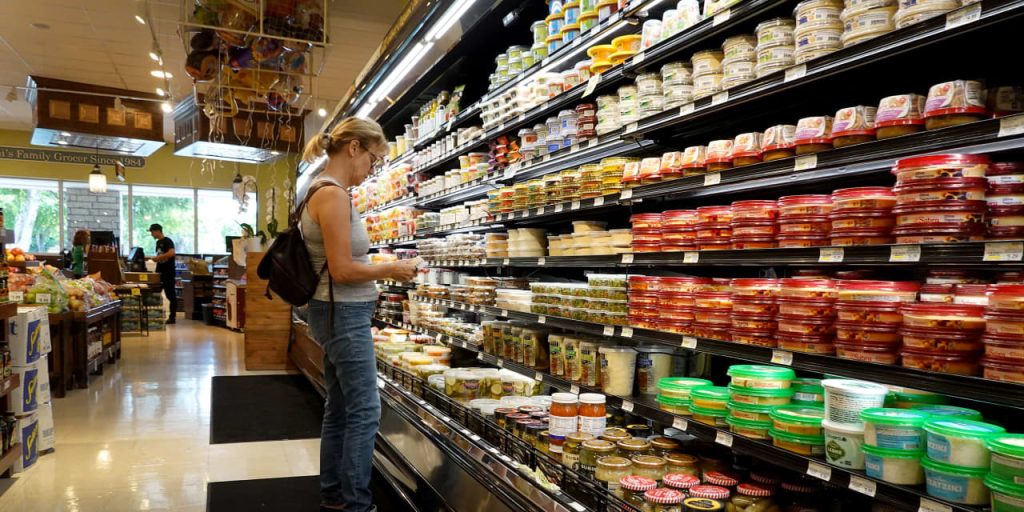The economy is still booming by many measures — such as gross domestic product, job creation and unemployment — but Americans still aren’t all that happy, and many are mad at President Joe Biden.
Why? It’s pretty simple. Everything costs more than it used to.
“People are going to the store, and they’re paying much more for the basics of life than they were two years ago, three years ago. And they’re not happy about it,” Federal Reserve Chair Jerome Powell said last week.
“And it’s fine that inflation is coming down,” he added, “but the prices they’re paying are still high.”
The cost of putting food on the table offers a telling example. Grocery prices were 22% higher at the end of 2023 than they were at the end of 2019, according to the consumer-price index.
“‘It’s fine that inflation is coming down, but the prices they’re paying are still high.’”
In contrast, from 2016 to 2019, grocery prices stayed the same. They rose just 11% in the entire decade prior to the pandemic.
And it’s not just food. Many staples — such as rent, gasoline, electricity, car insurance and cable TV — are much more expensive now then they were before the pandemic.
“Most Americans are price sensitive,” said Sam Bullard, senior economist at Wells Fargo in Charlotte, N.C. “They’re searching for deals. They are making judgments daily on how much they spend to stretch their dollars.”
One way to stretch dollars is to substitute cheaper products for more expensive ones — ground beef for strip steak, for example, or store brands for brand names.
Even those step-down decisions show how high inflation is eroding the standard of living Americans are accustomed to.
The unease is evident in surveys of consumer confidence. Take the long-running consumer-sentiment survey, for example: The survey reading fell to an all-time low of 50 points in the middle of 2022 as inflation hit a 40-year high of 9%. While the reading has since rebounded to 79, it’s still 22 points below its prepandemic peak.
And what’s the No. 1 financial worry among U.S. consumers? You guessed it: inflation.
Rising wages have partly offset the increases in prices, with many workers earning big raises over the past few years as a labor shortage forced companies to pony up. People who switched jobs got even bigger pay raises.
The typical worker’s paycheck, adjusted for inflation, is about 1.5% higher now compared with four years ago.
Not all workers have seen their pay rise faster than inflation, however, and big increases in certain expenses such as rent and food have hit some families harder than others.
Robert Frick, a corporate economist at Navy Federal Credit Union, said that while upper- and middle-income families are doing pretty well, Americans of lesser means are not.
Lower-income families pay as much as 30% of their income on food and another 30% on transportation, he noted. The costs of both have skyrocketed in the past few years.
The stresses these families are facing are evident in rising rates of default on credit cards and car loans.
“Lower-income Americans are being burdened,” Frick said.
If there is a silver lining, it’s that inflation has decelerated a lot faster than expected. The rate of inflation has slowed to around 3%, not far from the prepandemic level of 2%.
The sharp slowdown in inflation didn’t come without a big cost, though. The Fed jacked up interest rates to the highest level in 22 years to help get prices under control.
The higher cost of borrowing socked the housing market, hurt business investment and weighed on other interest-rate-sensitive industries. Many prospective home buyers were priced out of the market as mortgage rates topped 7%, up from less than 3% a few years ago.
Inflation is still going up, meanwhile, even if slowly, and the lingering effects of high prices are likely to last quite awhile. And it could take several years or longer for rising wages and salaries to restore price levels to prepandemic trends.
The outcome of the 2024 presidential election could hinge in part on who voters blame for high inflation. But there’s one thing Americans probably shouldn’t expect: falling inflation.
The cost of some goods and services might decline, but the rate of overall U.S. inflation has fallen in only one year since 1960.
Read the full article here
